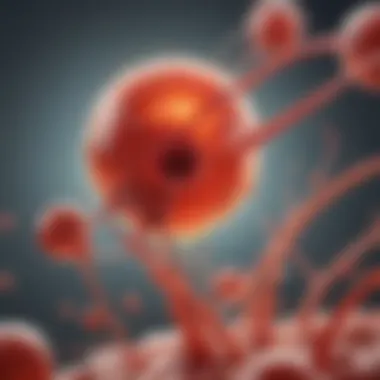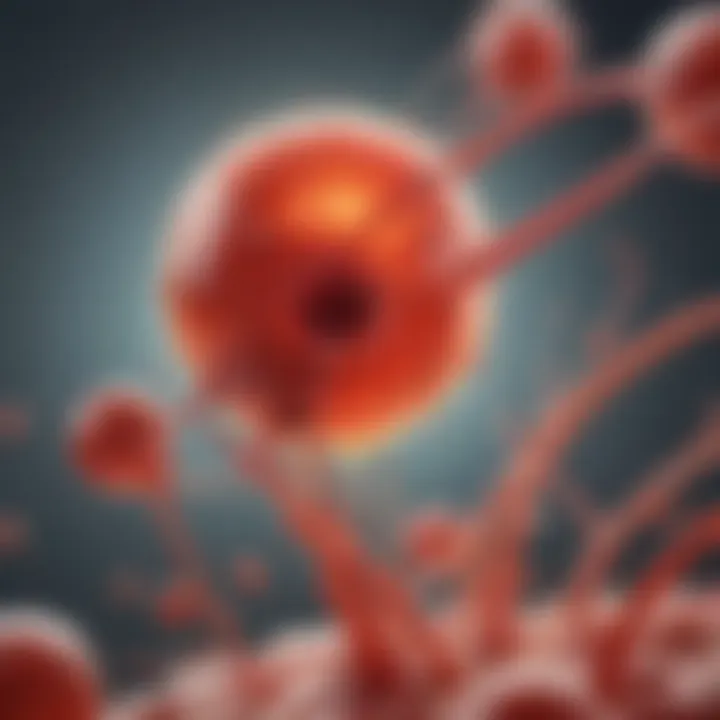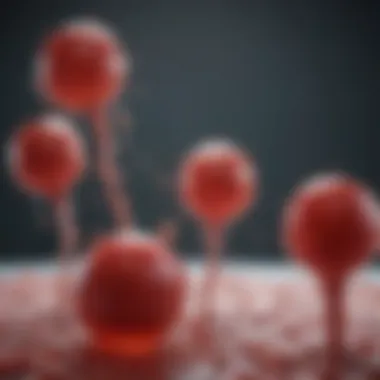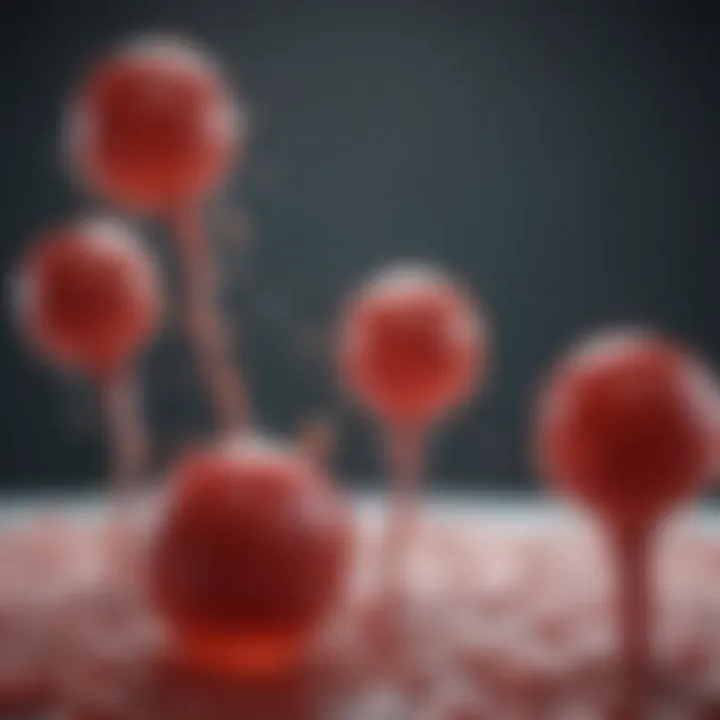The Intricacies of Platelet Mechanisms and Functions


Intro
This article explores the intricate biology of platelets, focusing on their roles and mechanisms within the circulatory system. Understanding how platelets function is essential for grasping their contributions to hemostasis and thrombosis. Hemostasis is the process that prevents and stops bleeding, while thrombosis refers to the formation of blood clots within blood vessels. This duality of functions underscores the importance of platelets in both health and disease.
Platelets are small, disk-shaped cell fragments crucial for vascular integrity. Their activation can result in either beneficial processes like wound healing or detrimental ones leading to heart attacks and strokes. This article synthesizes current knowledge about platelets, from formation to the latest research on therapeutic applications, providing insights into how they maintain homeostasis in the body.
Preface to Platelets
Platelets are an essential component of the human circulatory system. Their role in hemostasis, the process that prevents and stops bleeding, cannot be overstated. Understanding platelets is crucial, not just in academic research, but also in clinical practice. As the discussion unfolds in this article, it will become clear that a comprehensive grasp of platelet mechanisms is important for developing therapeutic approaches in cardiovascular diseases and bleeding disorders.
In the forthcoming sections, we will explore various dimensions of platelets. For example, their formation from megakaryocytes in the bone marrow, the structural elements that contribute to their function, and the processes of activation and aggregation will be addressed. Each of these elements plays a pivotal role in how platelets function within the body, particularly in response to vascular injury. Understanding these aspects is vital for researchers and practitioners alike, as it lays the groundwork for potential innovations in treatment.
Tremendous strides have been made in platelet research, thus revealing their multiple facets. Investigating these aspects will not only provide insights into basic biological functions but potentially lead to the development of novel therapeutic strategies for cardiovascular conditions.
Definition and Basic Function
Platelets, or thrombocytes, are small, disc-shaped cell fragments found in blood. They arise from the large megakaryocyte cells present in the bone marrow. Their primary function is to facilitate hemostasis. When blood vessels are injured, platelets rapidly aggregate at the site, adhering to the exposed endothelial surfaces and each other. This accumulation helps form a temporary "platelet plug" to halt blood loss. In addition to this crucial function, platelets also play diverse roles in wound healing and immune response.
The process of hemostasis involves several steps such as adhesion, activation, and aggregation. Upon injury to a blood vessel, specific receptors on the platelet surface interact with components of the exposed extracellular matrix. This interaction triggers a change in shape, activation of signaling pathways, and recruitment of more platelets to the injury site.
Historical Perspective
The study of platelets has a rich history. They were first described in the late 19th century by the German bacteriologist Paul Ehrlich. At that time, their role was not fully understood, but the observations marked a significant step in hematology. Over the decades, research has expanded, revealing more about their formation, function, and the impact they have on human health.
The advent of microscopy and later flow cytometry techniques has allowed researchers to analyze platelets in unprecedented detail. These advancements have shown that platelets are not merely passive participants in hemostasis but active players that respond to various stimuli during vascular injury. Today, ongoing research focuses on both normal platelet functions and how dysfunctions may contribute to diseases such as thrombosis and atherosclerosis, highlighting their significance not just in blood clotting but also in broader physiological and pathophysiological contexts.
"Understanding platelets is fundamental not only for hemostasis but also for addressing various health conditions related to vascular integrity."
In summary, the exploration of platelets involves numerous key functions and historical context. Their role in hemostasis and medical significance should not be underestimated, as knowledge gained from studying them continues to shape therapeutic strategies across multiple domains. This article aims to delve deeper into these mechanisms, enhancing the reader's understanding of platelets within the circulatory system.
Platelet Formation
Platelet formation is a critical process in the overall function of these cellular components within the circulatory system. The role of platelets goes beyond simple clotting mechanisms; they are essential for maintaining vascular integrity and reacting to injuries in the bloodstream. Understanding how platelets are formed is integral to grasping their multifaceted roles in hemostasis and pathology.
Megakaryocyte Development
The genesis of platelets originates from large precursor cells known as megakaryocytes. These cells reside primarily in the bone marrow. Megakaryocyte development is characterized by a process called endomitosis, where the cell undergoes several rounds of mitosis without undergoing cytokinesis. This results in a cell with multiple copies of DNA, leading to increased cell size and a complex internal structure.
Megakaryocytes play a pivotal role in platelet development through their elaborate cytoplasmic projections known as proplatelets, which extend into the bloodstream. Within these projections, cytoplasmic fragmentation occurs, leading to the release of platelets into circulation. The sheer size of megakaryocytes allows for the production of thousands of platelets from a single precursor cell, showcasing the efficiency in platelet manufacturing.
Release Into Circulation
Once formed, platelets are released into the bloodstream where they circulate for approximately 7 to 10 days. The release mechanism involves the interaction between the megakaryocyte membrane and the surrounding endothelial cells in the bone marrow sinusoids. This process is orchestrated by various factors, including hormonal signals and shear stress in the bloodstream, which favor platelet liberation.
The dynamic transition from megakaryocytes to circulating platelets is vital for maintaining hemostasis. Upon vascular injury, platelets rapidly migrate to the site, ready to engage in complex signaling and aggregating processes. This swift release is an essential aspect of the body's response to potential bleeding, underscoring the significance of understanding platelet formation in both health and disease states.
Platelet Structure
Understanding the structure of platelets is crucial to appreciating their functions within the circulatory system. While these cells are relatively small, their structural components play a significant role in their ability to respond to vascular injury, interact with other cells, and participate in hemostasis.
Cell Membrane Composition
The cell membrane of platelets is a complex arrangement of lipids and proteins. This membrane is not merely a barrier; it plays a central role in the functionality of platelets. The lipid bilayer contains phospholipids that provide fluidity and flexibility, allowing platelets to change shape when activated. Furthermore, specific proteins are embedded within the membrane, including receptors that detect signals from the external environment. These receptors, such as glycoprotein Ib (GPIb) and glycoprotein IIb/IIIa, are integral for platelet adhesion and aggregation.
The membrane also houses a rich assortment of glycoproteins, which serve crucial roles in cell signaling. These proteins can modulate platelet response to stimuli and are involved in the initial steps of the hemostatic process. The composition of the platelet membrane, especially under inflammatory conditions, can significantly affect their behavior and functionality, emphasizing the importance of this structure in both normal and pathological responses.
Granule Types and Contents
Platelets contain various types of granules that store proteins and other molecules essential for their role in hemostasis. There are two broad categories of granules: alpha granules and dense granules.
- Alpha Granules: These are the most abundant granules in platelets. They contain a wealth of proteins, including fibrinogen, von Willebrand factor, and platelet-derived growth factors. These proteins aid in clot formation and healing processes.
- Dense Granules: Less numerous than alpha granules, dense granules carry small molecules like ADP, ATP, calcium ions, and serotonin. These substances are crucial for platelet activation and recruitment of more platelets to sites of injury.
Overall, the granules’ contents are finely tuned to enable rapid responses upon activation. This intricate balance allows platelets to play their role effectively in both maintaining vascular integrity and responding to injury. The structure of platelets, especially their membranes and granule types, is thus a key focus in both the study of hemostasis and thrombotic diseases.
It is the unique structure of platelets that equips them with capabilities essential for preventing excessive bleeding and facilitating clot formation during vascular repair.


Mechanisms of Platelet Activation
Platelet activation is a critical process that underscores the overall functionality of platelets in hemostasis and thrombosis. Understanding the mechanisms involved is crucial, as these pathways determine how effectively platelets contribute to vascular integrity and respond to vascular injury. Activation is a complex interplay between various signals and cellular responses, which results in platelets undergoing substantial structural and functional changes.
The primary significance of exploring platelet activation lies in its bearing on both health and disease. Dysregulation of these mechanisms can lead to excessive platelet activation, resulting in conditions such as thrombosis. Conversely, insufficient activation may contribute to bleeding disorders. By dissecting the mechanisms of platelet activation, one may gather insights into novel therapeutic approaches that can either inhibit undue activation or enhance platelet function where needed.
Primary Activation Pathways
The primary activation pathways of platelets involve various stimuli that initiate the activation process. These stimuli can originate from both endogenous and exogenous sources. One of the most significant triggers for platelet activation is the exposure to collagen through the damaged endothelium. Other key activators include thrombin, adenosine diphosphate (ADP), and arachidonic acid.
Upon activation, platelets undergo a shape change from discoid to a more spherical form, allowing for better adhesion to the injury site. Key receptors on the platelet surface, such as glycoprotein VI (GPVI) and protease-activated receptors (PARs), are activated by these stimuli.
- Thrombin: This potent activator plays a central role in hemostasis. It activates platelets through PARs, which leads to further signaling cascades and enhances platelet aggregation.
- ADP: Released from activated platelets, ADP serves to recruit additional platelets to the site of injury. The P2Y12 receptor on platelets is instrumental in this process.
- Collagen: When vessels are damaged, collagen exposure is one of the first signals for platelets. GPVI binds to collagen, initiating the activation process.
Secondary and Amplifying Signals
In addition to the primary activation pathways, secondary and amplifying signals play a significant role in enhancing platelet responses. These signals are critical for full platelet activation and aggregation.
One of the most important secondary messengers is calcium. Upon activation, calcium ions flood into the platelet cytoplasm, triggering various intracellular processes that culminate in stronger platelet activation and shape change.
Furthermore, several other factors contribute to amplifying the platelet response:
- Thromboxane A2 (TXA2): Synthesized by activated platelets, TXA2 serves as a potent platelet aggregator and vasoconstrictor, reinforcing the activation driven by primary signals.
- Platelet Activating Factor (PAF): This phospholipid plays a role in recruiting more platelets to the site, magnifying the hemostatic response.
"Understanding the multifaceted pathways involved in platelet activation is essential for developing targeted therapies in thrombotic diseases."
The interplay between primary and secondary signaling pathways creates a highly efficient system that ensures immediate and robust responses to vascular injury.
Platelet Aggregation
Platelet aggregation is a crucial process in hemostasis, the mechanism that prevents blood loss from damaged vessels. Understanding this process sheds light on various aspects of cardiovascular health. When endothelial cells are injured, they expose collagen and other substances that activate platelets. This activation leads to several responses, including changes in shape and the release of granules containing signaling molecules.
Glycoprotein Receptors
Glycoprotein receptors on the surface of platelets play a vital role in aggregation. The two main receptors involved are glycoprotein IIb/IIIa and glycoprotein Ib/IX/V. The glycoprotein IIb/IIIa complex is the final common pathway in platelet aggregation, serving as a binding site for fibrinogen.
- Glycoprotein IIb/IIIa: This receptor undergoes a conformational change upon activation, allowing the platelets to bind fibrinogen. In the presence of fibrinogen, platelets adhere to one another, forming a stable aggregation.
- Glycoprotein Ib/IX/V: This receptor's primary function is to help platelets bind to von Willebrand factor, which is crucial for the initial adhesion of platelets to the exposed vascular surface after injury.
The significance of these receptors lies in their impact on clot formation. Drug therapies targeting these receptors, such as tirofiban and abciximab, are used to manage thrombosis and prevent occlusive cardiovascular events.
Formation of the Platelet Plug
When platelets aggregate, they form a platelet plug, an essential step toward achieving hemostasis. This process occurs in several phases:
- Adhesion: Activated platelets adhere to the site of vascular injury. Platelets bind to collagen through glycoprotein receptors and von Willebrand factor, which acts as a bridge between the platelets and the exposed collagen.
- Activation: Adhered platelets undergo activation, releasing adenosine diphosphate (ADP), thromboxane A2, and other pro-aggregatory factors that stimulate nearby platelets to aggregate further.
- Aggregation: Newly activated platelets then bind to each other through fibrinogen, creating a 'platelet plug'. This temporary fix serves to minimize blood loss until a stable fibrin clot can form.
The platelet plug is critical to prevent excessive bleeding, exhibiting the fine balance between hemostasis and thrombosis. Any malfunction in this process can lead to either excessive bleeding or thrombosis, both of which carry significant clinical ramifications.
The formation of a platelet plug is the body's immediate response to vascular injury, underscoring the importance of platelets in hemostatic processes.
Overall, the mechanisms of platelet aggregation demonstrate how platelets interact with the vascular environment and each other to ensure vascular integrity and proper clotting, thereby influencing broader cardiovascular health.
Role of Platelets in Hemostasis
Platelets play a crucial role in maintaining hemostatic balance within the human circulatory system. Their primary function is to prevent excessive bleeding when vascular injury occurs. Understanding hemostasis provides insight into how platelets contribute to cardiovascular health and disease. Here, we will explore two key aspects: the vascular injury response and the interaction with the coagulation cascade.
Vascular Injury Response
When a blood vessel is injured, it triggers a series of events that are vital for stopping blood loss. The first response of platelets involves their rapid activation and recruitment to the site of injury. This process can be divided into several steps:
- Adhesion: Platelets bind to exposed collagen and von Willebrand factor at the injury site.
- Shape Change: Activated platelets undergo a significant change in shape, which enhances their ability to interact with each other and with the vessel wall.
- Secretion: Upon activation, they release granular contents including ADP, thromboxane A2, and serotonin. These molecules serve to recruit more platelets and enhance aggregation.
The swift response of platelets to vascular injury is essential. If platelets fail to adhere and aggregate efficiently, this can lead to severe hemorrhage. In addition, the injury site becomes covered by a platelet plug, which plays a key role in preventing further blood loss and creating a temporary seal that facilitates tissue repair.
Coagulation Cascade Interaction


The interaction between activated platelets and the coagulation cascade is fundamental for effective hemostasis. The coagulation cascade comprises a series of proteins that ultimately lead to the formation of a fibrin mesh, which stabilizes the platelet plug. The relationship between platelets and the coagulation system entails several important points:
- Activation of Coagulation Factors: Activated platelets provide a surface for various coagulation factors to assemble. They significantly enhance the rate of thrombin generation, converting fibrinogen to fibrin.
- Feedback Mechanisms: Platelets release pro-coagulant factors that amplify the coagulation response. For instance, the release of calcium ions from platelets stimulates various aspects of the cascade.
- Stabilization of the Plug: The final fibrin mesh reinforces the platelet aggregate, transforming it into a more stable clot.
The collaboration between platelets and the coagulation cascade is a finely tuned process. Disruptions in either component can lead to conditions such as thrombosis or bleeding disorders, impacting overall vascular health.
Key Insight: Platelets not only act as first responders to vascular injury but also integrate with the coagulation cascade to ensure comprehensive hemostatic response.
Pathophysiological Aspects of Platelets
Understanding the pathophysiological aspects of platelets is essential for grasping their intricate roles in human health. These cellular entities are not just involved in hemostasis, but also play significant roles in various diseases. This section will highlight two core areas: thrombosis and platelet dysfunction disorders. By examining these, we can uncover the complexities of how platelets contribute to both protective mechanisms and potential pathologies in the circulatory system.
Thrombosis and Its Implications
Thrombosis occurs when platelets aggregate inappropriately, leading to the formation of a clot within a blood vessel. This process can become dangerous, resulting in conditions like deep vein thrombosis, pulmonary embolism, and myocardial infarction.
Key elements to consider include:
- Risk Factors: Certain conditions can exacerbate thrombosis risk. These include obesity, prolonged immobility, and genetic predispositions such as Factor V Leiden.
- Clinical Manifestations: Symptoms can vary depending on the affected area. For instance, a clot in the leg results in swelling and pain, while a clot in the coronary artery can lead to chest pain and shortness of breath.
- Therapeutic Considerations: Antiplatelet drugs, such as aspirin and clopidogrel, are commonly employed to reduce the risk of thrombosis. Understanding the underlying mechanisms that lead to thrombosis can aid in the development of more targeted therapies.
Thrombosis emphasizes the dual nature of platelet function, where their protective roles in hemostasis can paradoxically become detrimental in the presence of certain risk factors.
Platelet Dysfunction Disorders
Platelet dysfunction disorders encompass a range of conditions where platelet function is impaired. Patients with these disorders experience bleeding tendencies that can significantly affect quality of life. Such disorders can either be hereditary, like Glanzmann thrombasthenia, or acquired, often due to medication or chronic diseases.
Elements to explore in this context include:
- Symptoms: Common signs include easy bruising, frequent nosebleeds, and prolonged bleeding after cuts. These symptoms indicate that platelets are not functioning correctly even when they are present in sufficient numbers.
- Diagnosis: Proper assessment often involves specialized tests such as platelet aggregation studies, which measure how well platelets clump together in response to various stimuli.
- Management: Treatment may vary from prophylactic medications to platelet transfusions in severe cases. New advancements in therapies that target specific pathways in platelet activation show promise for future management options.
Understanding platelet dysfunction disorders not only reveals the importance of platelets in maintaining hemostasis but also highlights the challenges faced by healthcare practitioners in managing these complex conditions.
Thrombosis and platelet dysfunction disorders represent crucial areas in the study of platelets. Their impact on health can transform daily living for affected individuals, making research in this field pivotal for improving therapeutic approaches.
Regulatory Mechanisms
Regulatory mechanisms play a critical role in the functioning of platelets. They ensure that platelet activity is finely tuned to meet the demands of the circulatory system. These mechanisms are vital for maintaining vascular integrity while also preventing excessive or inappropriate platelet activation that could lead to pathological conditions. By examining these regulatory influences, we can gain insight into the delicate balance that platelets must strike in both health and disease.
Endothelial Influences
The endothelium, the thin layer of cells lining blood vessels, has a profound impact on platelet regulation. Endothelial cells release various substances that help to modulate platelet function. For example, nitric oxide and prostacyclin are two key endothelial-derived factors that serve to inhibit platelet activation. They do this by increasing intracellular cAMP levels, which in turn reduces the likelihood of aggregation.
On the other hand, endothelial injury results in the exposure of collagen and von Willebrand factor. This promotes platelet activation and adhesion, highlighting the dual role of the endothelium. Under normal conditions, the endothelium works to prevent thrombosis. When it is damaged, however, it can trigger a cascade of events leading to platelet aggregation and thrombus formation. Thus, the health of the endothelium is critical for regulating platelet activity effectively.
Systemic Factors in Platelet Activity
In addition to local endothelial influences, systemic factors also significantly affect platelet function. Hormones, such as thromboxane A2, promote platelet aggregation while others can inhibit it. For instance, adrenergic hormones can enhance platelet reactivity during stress or injury, reflecting the body’s response to external challenges.
Moreover, vascular shear stress is a crucial determinant of platelet behavior. Higher shear rates can facilitate the interaction between platelets and the vessel wall, influencing their activation and aggregation dynamics.
Factors circulating in the blood, such as fibrinogen, also play essential roles in platelet function. Fibrinogen binds to glycoprotein receptors on the platelet surface, promoting aggregation during hemostatic responses.
Understanding these systemic influences is vital for unraveling the complexities of platelet function. It emphasizes the interplay between local and systemic factors in regulating platelet activity, which ultimately targets therapeutic interventions in various platelet-related conditions.
Platelets and Inflammation
Inflammation is a complex biological response of the body's vascular system to harmful stimuli, such as pathogens or tissue injury. Platelets play a crucial role in this process, serving as key players in the interplay between hemostasis and immune function. Understanding the relationship between platelets and inflammation is essential for comprehending many pathological conditions, including cardiovascular diseases, autoimmune disorders, and infections. This section will explore the mechanisms of platelet interaction with immune cells as well as their role in modulating inflammatory responses.
Platelet Interaction with Immune Cells
Platelets are not just involved in clotting; they also interact extensively with various types of immune cells, such as neutrophils, macrophages, and lymphocytes. This interaction enhances the immune response and promotes inflammation.
- Activation of Immune Cells: When platelets are activated, they release several substances that can recruit and activate immune cells. For example, platelets release cytokines and chemokines, which can attract neutrophils to the site of injury or infection.
- Direct Contact: Platelets can physically interact with immune cells. They use specific receptors on their surface to bind to leukocytes, facilitating communication between platelets and these immune cells. This interaction contributes to the formation of the immune synapse, which enhances immune responses.
- Inflammatory Mediators: Platelets secrete various pro-inflammatory substances, such as interleukin-1 (IL-1) and tumor necrosis factor-alpha (TNF-α). These mediators play an important role in amplifying the inflammatory response, resulting in a heightened immune reaction towards pathogens or damaged tissues.
Inflammatory Response Modulation


Platelets serve a dual role in inflammation. While they promote inflammation under certain conditions, they can also help modulate and resolve it. This balance is critical for preventing excessive tissue damage and ensuring effective healing.
- Resolution of Inflammation: Platelets can release anti-inflammatory mediators like transforming growth factor-beta (TGF-β) and adenosine. These substances contribute to the resolution of inflammation by inhibiting the activation of neutrophils and promoting the return to homeostasis.
- Homeostasis Restoration: The ability of platelets to coordinate the resolution phase is essential in restoring tissue integrity. By managing the transition from pro-inflammatory to anti-inflammatory phases, platelets help maintain tissue health.
"Platelets are multifaceted players in the immune response, bridging hemostasis and inflammation to adapt to the body’s needs."
Research Advances in Platelet Studies
Research into platelets has progressed significantly in recent years. This progress is essential for improving our understanding of various cardiovascular diseases. In this section, we will explore the importance of this research. We will emphasize key findings and innovations that are enhancing our knowledge of platelet functions and their implications in health and disease.
Recent advances in technology and methodology have allowed scientists to study platelets in ways previously thought impossible. This includes more precise imaging techniques and the ability to analyze platelets at single-cell levels. Such advancements enable researchers to observe how platelets react in real-time, leading to a deeper understanding of their behavior during hemostatic processes.
By investigating the pathways that govern platelet activation and aggregation, researchers can identify potential therapeutic targets. Understanding these mechanisms is vital for developing effective treatments for thrombotic diseases. Each finding not only unearths how platelets function but also highlights broader implications for patient care.
Novel Therapeutic Approaches
Therapeutic developments based on recent platelet research have the potential to revolutionize treatment strategies for various conditions. One promising avenue is the creation of new antiplatelet agents. These are being designed to specifically target the key receptors on platelets, such as glycoprotein IIb/IIIa and P2Y12 receptors. The goal is to enhance safety and efficacy while minimizing side effects.
Moreover, advancements in gene therapy are beginning to show promise. Experimental treatments involving RNA interference target specific genes to inhibit excessive platelet function. This could be a game-changer for patients with conditions like acute coronary syndrome, where inhibiting platelet activity can prevent serious complications.
Genetic and Molecular Research
Genetic and molecular studies are pivotal in understanding the biological variations in platelet function among individuals. Researchers have identified genetic polymorphisms that can influence platelet response to various stimuli. These discoveries are crucial for personalized medicine approaches.
For instance, certain genetic markers are linked to increased risk of thrombotic events. Understanding these links could lead to targeted screening processes for high-risk individuals. Additionally, studies examining the role of epigenetics in platelet function are on the rise. As our knowledge in this field expands, it may lead to breakthroughs in therapeutic interventions.
Clinical Implications of Platelet Function
Platelets play a crucial role in the maintenance of hemostasis and thus have significant clinical implications. Understanding platelet function is essential, as it directly impacts patient care in various contexts, including cardiovascular health, surgical procedures, and the management of bleeding disorders. The clinical relevance of platelets spans across several domains including diagnostics, therapeutic interventions, and the monitoring of treatment efficacy.
Antiplatelet Therapies
Antiplatelet therapies are a key aspect of managing cardiovascular diseases. These treatments inhibit platelet activation and aggregation, thereby reducing the risk of thrombus formation. Common drugs, such as aspirin and clopidogrel, target specific pathways of platelet activation, making them central in the secondary prevention of cardiovascular events like heart attacks and strokes.
- Aspirin: Traditionally used, it functions by irreversibly inhibiting cyclooxygenase-1, reducing thromboxane A2 production, a potent platelet activator.
- Clopidogrel: This drug works by inhibiting the P2Y12 ADP receptor on platelets, thereby blocking further activation and aggregation in response to stimuli.
The choice of therapy often depends on individual patient risk factors such as age, comorbidities, or prior events. In addition, the synergy between different antiplatelet agents can enhance therapeutic outcomes, but there are risks associated with increased bleeding. Thus, careful patient selection and monitoring are essential to optimize the benefits and minimize potential complications associated with antiplatelet therapy.
Platelets in Disease Diagnosis
Platelets also have a significant role in disease diagnosis. Their activity can provide insights into various conditions, such as cardiovascular diseases and hematological disorders. For example, the platelet count and functionality tests can indicate diseases like thrombocythemia or thrombocytopenia.
Moreover, markers of platelet activation can serve as indicators of ongoing vascular injury or inflammation. Biomarkers, such as soluble P-selectin and platelet factor 4, are often associated with acute coronary syndromes.
Key considerations in diagnosing diseases through platelets include:
- Thromboelastography (TEG): This test evaluates the viscoelastic properties of platelets and coagulation status. It is particularly valuable in guiding treatment during surgeries and trauma care.
- Flow Cytometry: This technique is used for analyzing platelet activation status by measuring surface receptors and intracellular signaling within platelets.
In diagnosing and managing these conditions, combining platelet function tests with standard clinical indicators improves the likelihood of effective interventions and enhances outcomes.
"The clinical implications of platelet functionality are vast, influencing therapeutic strategies and guiding diagnostic criteria in patient care."
In summary, the clinical implications of platelet function are vital for understanding their role in health and disease. This understanding helps craft more effective treatment plans and improves diagnostic accuracy, ultimately enhancing patient outcomes.
End
The concluding section of this article encapsulates the multifaceted roles platelets play in the human circulatory system. Understanding the various functionalities of platelets is critical in both physiological and pathological contexts. This article has explored how platelets are essential actors in hemostasis, facilitating rapid responses to vascular injury and engaging in thrombus formation. The insights gained from this journey underscore the importance of platelets beyond their traditional role in clotting; they are also significant in inflammation and immune responses.
Summary of Platelet Functions
Platelets fulfill several vital functions in maintaining vascular health, which include:
- Hemostasis: The primary function where platelets adhere to damaged endothelial surfaces, aggregate, and form a plug, minimizing blood loss.
- Cytokine Release: Platelets release growth factors and cytokines that mediate repair processes and attract other immune cells.
- Interaction with Immune Cells: They have a role in modulating immune responses, impacting inflammatory pathways.
- Coagulation Cascade Support: Platelets interact with various proteins and factors in the blood to stabilize the clotting process.
Understanding these functions lays the groundwork for recognizing platelet behavior in both health and disease scenarios. It informs clinical practices where platelet count and function are pivotal in diagnosing disorders and managing cardiovascular conditions.
Future Directions in Platelet Research
Research in platelet functionality is rapidly evolving, promising significant advances in medical science. Here are some intriguing avenues for future studies:
- Targeted Therapies: There is a growing interest in developing therapies that can specifically target platelet activation pathways to reduce thrombotic events without compromising hemostasis.
- Platelets as Biomarkers: Ongoing investigations are seeking to establish platelet characteristics as biomarkers for various diseases, paving the way for non-invasive diagnostic approaches.
- Platelet Genomics: The exploration of genetic factors influencing platelet behavior can reveal new insights into personalized medicine.
- Role in Chronic Diseases: Further research is needed to understand how platelets contribute to chronic inflammatory diseases, such as diabetes and atherosclerosis.
The path ahead in platelet research holds potential for not only expanding our fundamental understanding of these cells but also improving patient care through innovative treatments. Engaging in these studies will elevate our comprehension of cardiovascular health and enhance intervention strategies in thrombotic disorders.



